Ob nun Nouruz, Nowruz oder Nowrouz, unabhängig von der Schreibweise wird heute das persische Neujahrsfest gefeiert!
Das Fest wird auch in anderen Ländern zelebriert, ich werde mich auf die mir bekannte persische Art konzentrieren und euch in diesem Beitrag ein wenig mehr darüber erzählen.
Whether it's Nouruz, Nowruz or Nowrouz, regardless of the spelling, the Persian New Year is celebrated today! The festival is also celebrated in other countries, but I will focus on the Persian way I'm familiar with and tell you a little more about it in this post.
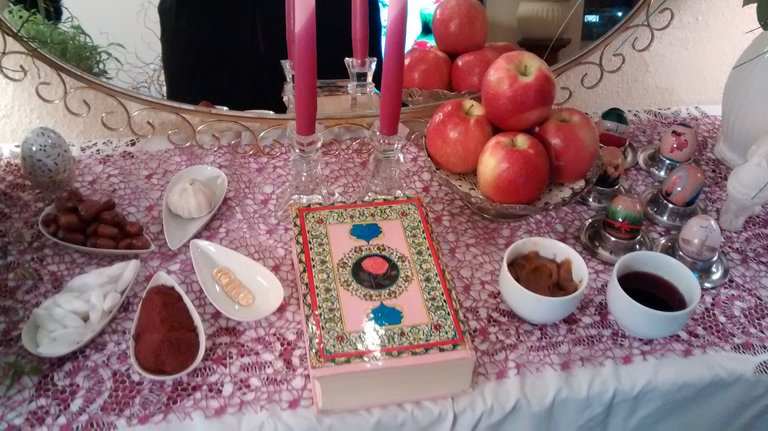
Das persische Neujahr wird an keinem festen Tag gefeiert sondern findet immer zum Frühlingsanfang statt. Dieses Jahr ist das also der 20. März um 16:33 Uhr (Berlin-Zeit). Eine krumme Zahl zu haben ist ziemlich lustig, wir saßen schon manchmal zusammen und haben bei den ganzen Gesprächen den Übergang verpasst.
Wir feiern heute übrigens auch nicht den Beginn des Jahres 2022. Der persische Kalender richtet sich nicht nach Jesus Christus sondern beginnt mit der Flucht des Propheten Mohammed nach Medina. Also ein fröhliches neues 1401 an alle!
By the way, we are not celebrating the beginning of the year 2022 today. The Persian calendar is not based on Jesus Christ but begins with the flight of the prophet Mohammed to Medina. So a happy new 1401 to all!
The Persian New Year is not celebrated on a fixed day, instead it takes place at the beginning of spring. So this year it is March 20th at 16:33 (Berlin time). Having a crooked number is pretty funny, we've been sitting together sometimes and missed the transition during all the conversations.
Zum Neujahr gibt es einen Gabentisch, Haft Sin genannt. Auf diesen Tisch kommen sieben Gegenstände die mit dem Buchstaben "S" beginnen. Es gibt auch noch ein paar optionale Gaben, aber diese Sieben sind der Hauptteil.
For the New Year, there is a gift table called Haft Sin. On thiat table are seven items that begin with the letter "S". There are also a few optional gifts, but these seven are the main focus.
Sabze (Grünes, oft Linsensprossen) symbolisiert Munterkeit
Samanak (Malz aus Weizen) symbolisiert Wohltat und Segen
Sir (Knoblauch) symbolisiert Schutz
Sendsched (Mehlbeere) symbolisiert die Saat bzw. den Keim des Lebens
Serkeh (Essig) symbolisiert Geduld und Fröhlichkeit
Somagh (Gewürzsumach) symbolisiert den Geschmack des Lebens
Sib (Apfel) symbolisiert Schönheit und Gesundheit
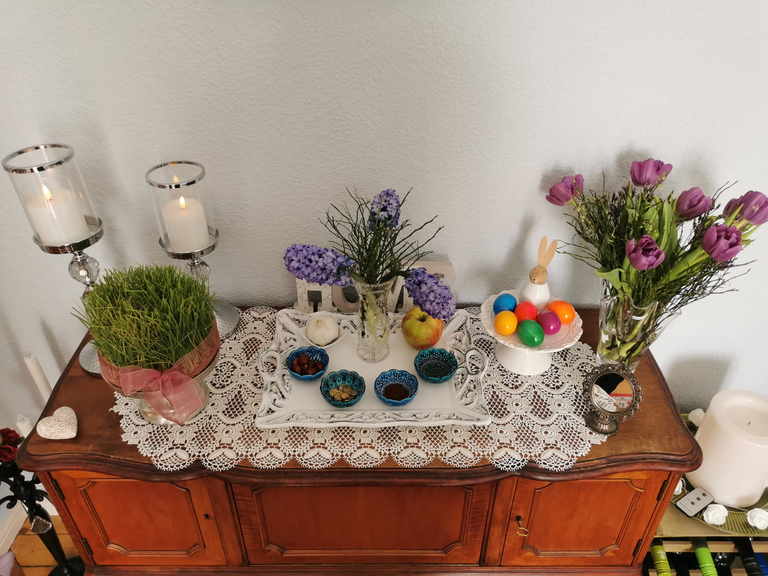
Sabze (greens, often lentil sprouts) symbolizes cheerfulness
Samanak (malt from wheat) symbolizes beneficence and blessing
Sir (garlic) symbolizes protection
Sendsched (whitebeam) symbolizes the seed or sprout of life
Serkeh (vinegar) symbolizes patience and cheerfulness
Somagh (spice sumac) symbolizes the taste of life
Sib (apple) symbolizes beauty and health
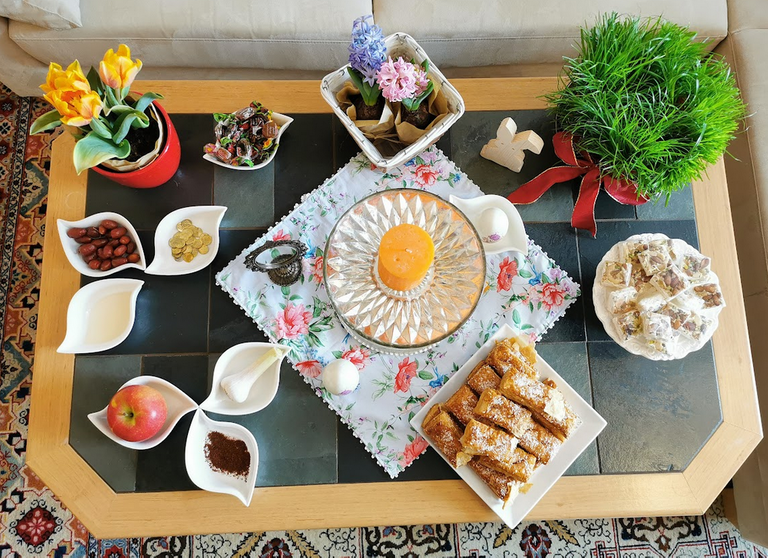
Zu den optionalen Gegenstängen zählen zum Beispiel Hyazinthen, Goldmünzen und Kerzen (Feuer). Goldfische gehören auch dazu, in einem Jahr kam mein Vater einfach mit einem Goldfisch an. Wir hatten nichts da um uns um einen Fisch zu kümmern! Nach ersten Tagen in einem alten Kaffeepot gab es dann doch ein eigenes Glas und der kleine Balduin hat über zehn Jahre gelebt.
Optional items include for example hyacinths, gold coins and candles (fire). Goldfish count as well, one year my father just arrived with a goldfish. We had nothing there to take care of a fish! After the first few days in an old coffee pot we got it a real bowl and the little Balduin lived over ten years.
Worauf sich all gefreut haben: Essen. Es gibt Safran-Reis mit knusprigem Tadhig, Fisch, Kuku Sabzi (Kräuteromelette), frisches Gemüse und Torshi (sauer eingelegtes Gemüse). Durch Corona hatten wir jetzt lange keine großen Familientreffen mehr, ich vermisse den eingelegten Knoblauch meiner Großtante... 20 Jahre reifen lassen und der Knoblauch schmilzt in deinem Mund.
What everyone was looking forward to: Food. There is saffron rice with crispy tadhig, plaice, kuku sabzi (herb omelet), fresh vegetables and torshi (pickled vegetables). Due to Corona we haven't had big family gatherings in a long time now, I miss my great aunt's pickled garlic.... Let it age for 20 years and the garlic melts in your mouth.
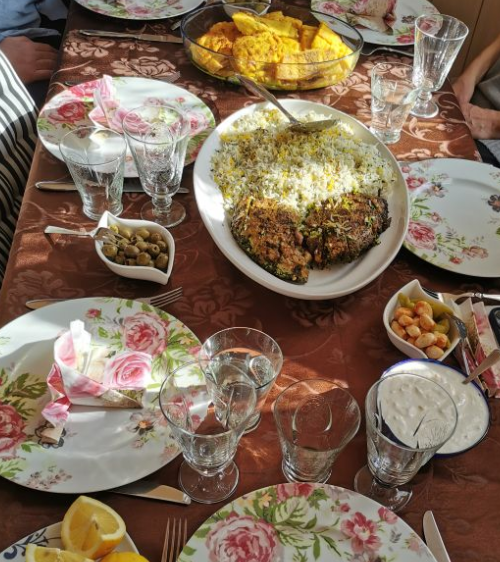
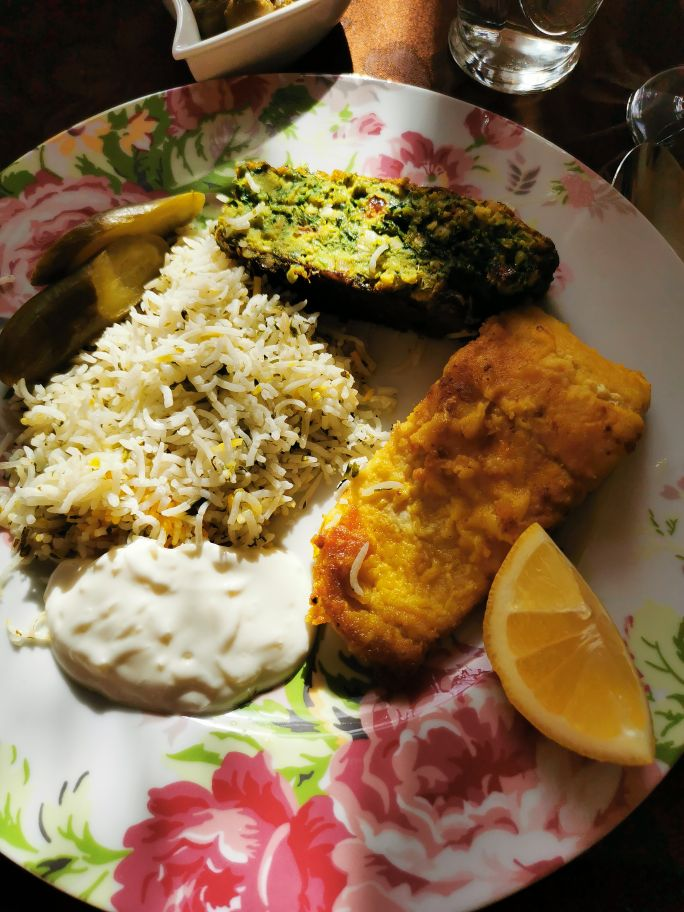
Nowruz ist übrigens bei den Kindern auch sehr beliebt, da es hier Geschenke gibt! Die älteren Familienmitgliedern schenken den Kindern Geld, traditional werden die Scheine in ein heiliges Buch gelegt und dann aufgeblättert. Das war früher natürlich das Highlight, jetzt freut man sich über die Gesellschaft. Hach, das Alter. ;)
By the way, Nowruz is also very popular with the children, because there are gifts! The older family members give the children money, traditionally the bills are placed in a sacred book and then browsed open. This used to be our highlight, now we are just happy to be in good company. Oh, the age. ;)
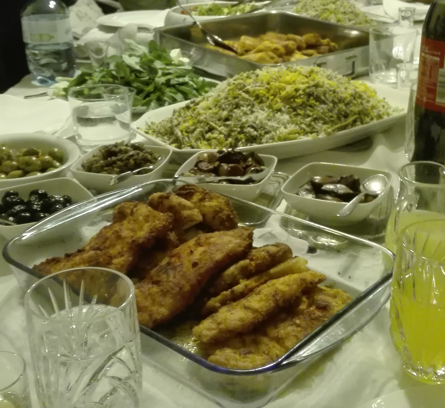
So, das war es von mir! Ich wollte den Post kurz halten und euch dennoch das Fest ein wenig näher bringen. Es gibt noch andere Bräuche wie das Mittwochseuer vor dem Fest, das habe ich allerdings noch nie selbst erlebt. Das Ganze hier ist meiner deutschen Sicht. Mein Vater hätte bestimmt noch einiges mehr zu erzählen. 😁 Hoffentlich konntet ihr trotzdem etwas Spannendes lernen.
So, that was it from me! I wanted to keep the post short and still bring you the festival a little closer. There are other customs like the wednesday fire before the festival, but I have never experienced that myself. The whole thing here is my German view. My father would certainly have a lot more to tell. 😁 I hope you could still learn something interesting.










